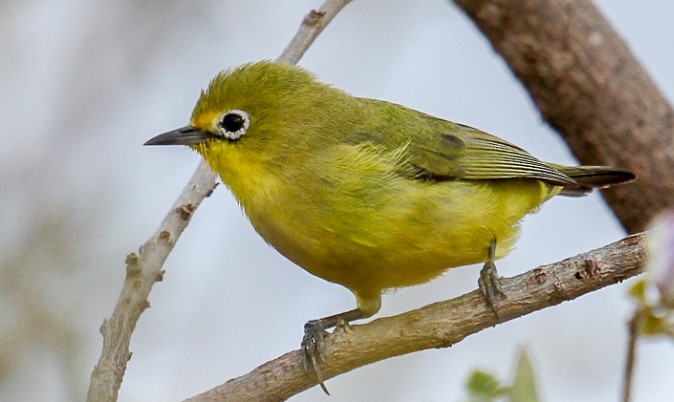Habitats: Throughout Australia, pale white-eye (Zosterops citronella) is found on small offshore islands in the Torres Strait and Cape York Peninsula. There, they are usually found in groups of between six and eight within shrubby thickets. Their diet consists of insects and berries found among the foliage of low trees and shrubs. As they feed, they whistle softly, mewing, typical of white eyes, to keep in contact with each other as they dash from shrub to shrub. Pale white-eyes are rare and difficult to identify; almost nothing is known about their habits. In northeastern Queensland, silvereyes are occasionally mistaken for white-eyes, but white-eyes have deeper yellow throats and plain citrine backs; silvereyes have a gray band across their backs.
Identification: There are similarities between the two adults. There is a light citrine-green color on the upper parts and a yellower color on the forehead. There is a dusky gray edge to the wing feathers and a citrine edge to the tail feathers. There is a narrow white ring around the eye, and there is a black line under the eye. There is a clear, deep yellow color from the throat to the upper breast and undertail. A wash of gray covers the flanks and lower breast. Mid-brown is the color of the eyes. At the lower base of the bill, the bill is grayer than black-grey. A lead gray color covers the feet.
Immatures: Similar to adults but duller; throat is lemon-yellow.
Nesting and Breeding: Nesting and breeding last between December and June, and nesting occurs mainly during the wet season. In most cases, nests are deep, cup-shaped, and made of dried leaf skeletons bound with cobwebs. There is a fine grass liner and broad, thin strips of paperbark on the outside of the nest; it measures about 80 mm in diameter and 50 mm in depth, and it hangs from a horizontal fork of a shrub.
Eggs: The bird lays 2 to 4 pale blue-green eggs. The size is 17 x 13 millimeters and tapered-oval in shape.
Other Names: Pale Silvereyes and Pale-bellied Silvereyes are also names for the species.
Call: In contact, Pale White-Eye whistles a single, soft chirp.
Song: Pale white-eye sings rich, soft warbles, whistles, and trills from perch in thickets, as do other white-eyes.
Size: There is about 100–110 mm between the length and the width of the pale white eye.
Distribution: The Pale White-eye is found on small wooded islands in Torres Strait and off the Eastern Cape York Peninsula, north to Palfrey Island, near Cooktown, Queensland. The species is common locally. The Tanimbar and Lesser Sundas are also home to this species. There are three races, but only one in Australia.
Read More: Ashy-bellied white-eye (Zosterops citrinella)







